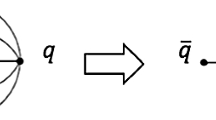Abstract.
We derive a partition function for the Lund fragmentation model and compare it with that of a classical gas. For a fixed rapidity “volume” this partition function corresponds to a multiplicity distribution which is very close to a binomial distribution. We compare our results with the multiplicity distributions obtained from the JETSET Monte Carlo for several scenarios. Firstly, for the fragmentation vertices of the Lund string. Secondly, for the final state particles both with and without decays.
Similar content being viewed by others
Author information
Authors and Affiliations
Additional information
Received: 27 August 1998 / Published online: 15 October 1998
Rights and permissions
About this article
Cite this article
Andersson, B., Gustafson, G., Ringnér, M. et al. The Feynman–Wilson gas and the Lund model. Eur. Phys. J. C 7, 251–261 (1999). https://doi.org/10.1007/s100529801010
Issue Date:
DOI: https://doi.org/10.1007/s100529801010



